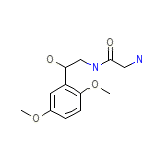Methbipyranone




Methbipyranone Brand names, Methbipyranone Analogs
Methbipyranone Brand Names Mixture
- No information avaliable
Methbipyranone Chemical_Formula
C12H18N2O4
Methbipyranone RX_link
http://www.rxlist.com/cgi/generic3/midodrine.htm
Methbipyranone fda sheet
Methbipyranone msds (material safety sheet)
Methbipyranone Synthesis Reference
No information avaliable
Methbipyranone Molecular Weight
254.282 g/mol
Methbipyranone Melting Point
200 to 203°C
Methbipyranone H2O Solubility
Soluble
Methbipyranone State
Solid
Methbipyranone LogP
0.159
Methbipyranone Dosage Forms
2.5-mg and 5-mg tablets for oral administration
Methbipyranone Indication
For the treatment of symptomatic orthostatic hypotension (OH).
Methbipyranone Pharmacology
Midodrine is a prodrug, i.e., the therapeutic effect of orally administered midodrine is due to the major metabolite desglymidodrine formed by deglycination of midodrine. Desglymidodrine diffuses poorly across the blood-brain barrier, and is therefore not associated with effects on the central nervous system. Administration of midodrine results in a rise in standing, sitting, and supine systolic and diastolic blood pressure in patients with orthostatic hypotension of various etiologies. Standing systolic blood pressure is elevated by approximately 15 to 30 mmHg at 1 hour after a 10-mg dose of midodrine, with some effect persisting for 2 to 3 hours. Midodrine has no clinically significant effect on standing or supine pulse rates in patients with autonomic failure.
Methbipyranone Absorption
Rapidly absorbed following oral administration. The absolute bioavailability of midodrine (measured as desglymidodrine) is 93% and is not affected by food.
Methbipyranone side effects and Toxicity
Symptoms of overdose could include hypertension, piloerection (goosebumps), a sensation of coldness and urinary retention. The single doses that would be associated with symptoms of overdosage or would be potentially life- threatening are unknown. The oral LD50 is approximately 30 to 50 mg/kg in rats, 675 mg/kg in mice, and 125 to 160 mg/kg in dogs. Desglymidodrine is dialyzable.
Methbipyranone Patient Information
No information avaliable
Methbipyranone Organisms Affected
Humans and other mammals














